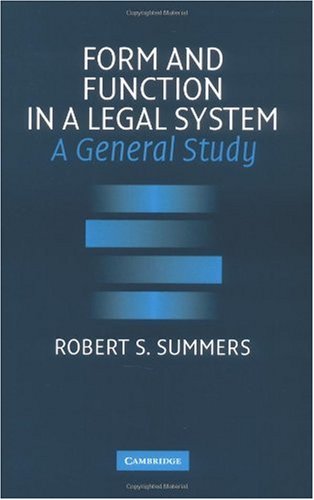Robert S. Summers0521857651, 9780521857659, 9780511140891
Table of contents :
Cover……Page 1
Half-title……Page 3
Series-title……Page 4
Title……Page 5
Copyright……Page 6
Dedication……Page 7
General Table of Contents……Page 9
Detailed Table of Contents……Page 11
Preface……Page 15
Acknowledgments……Page 17
PART ONE: Introduction, Basic Concepts and Definitions, and A General Approach……Page 19
Section One: Preliminary Overview……Page 21
Section Two: Importance of Legal Form……Page 35
Section Three: The Neglect of Form……Page 42
Section Four: Protests Against Misunderstanding……Page 51
Section Two: A selection of functional legal units and their overall forms……Page 55
Section Three: The overall form of a functional legal unit – a general definition and refinements……Page 57
Section Four: Types of purposes that overall form is to serve – a more extended account……Page 60
Section Five: Rationales for the general definition of overall form adopted here……Page 65
Section Six: Differentiation of the overall form from material or other components of a functional legal unit……Page 75
Section Seven: The “Form v. Substance” Contrast……Page 79
Section Two: Advancing Understanding Through Study of Form……Page 82
Section Three: Attributing Credit to Form for Purposes Served……Page 84
Section Four: A form-oriented approach as primary, with a rule-oriented one secondary……Page 90
PART TWO: The Forms of Functional Legal Units……Page 107
Section One: Introduction……Page 109
Section Two: Overall Legislative Form and Its Constituent Features……Page 115
Section Three: The Compositional Feature……Page 119
Section Four: The Jurisdictional Feature……Page 126
Section Five: The Structural Feature……Page 130
Section Six: The Procedural Feature……Page 134
Section Seven: The Preceptual Feature……Page 144
Section Eight: Form and the Unity of the Legislature……Page 145
Section Nine: Skepticism about institutional and other form, and responses thereto……Page 149
Section One: Introduction……Page 154
Section Two: Internal Formal Features of Rules……Page 159
Section Three: The Feature of Prescriptiveness……Page 161
Section Four: The Feature of Completeness……Page 165
Section Five: The Feature of Definiteness……Page 173
Section Six: The Feature of Generality……Page 179
Section Seven: The Feature of Structure……Page 182
Section Eight: The Encapsulatory Feature……Page 188
Section Nine: The Expressional Feature……Page 194
Section Ten: Responses to Objections……Page 197
Section One: Introduction……Page 200
The Purpose of Formulating and Implementing Policy and Similar Social Ends…….Page 201
The Purpose of Serving the Rule of Law…….Page 202
The Purpose of Serving Fundamental Political Values…….Page 203
Section Three: Initial choices of policy or other content and of formal features in a projected rule……Page 206
Section Four: Further Initial Choices of Formal Features……Page 208
Section Five: Final choices of form and final choices of policy and other content……Page 217
Section Six: General interactions and other inter-relations between choices of form and choices of content……Page 221
Section Seven: Further Responses to Objections……Page 225
Section One: Introduction……Page 229
Section Two: Choices of form and of complementary material or other components of content in a contract……Page 233
Section Three: Due Credit to Form……Page 239
Section Four: Formal prima-facie validity and further credit due to form……Page 246
Section Five: Contractual form and related property interests – still further credit to form……Page 250
Section Six: Implementation of contractual and related property law – credit to form continued……Page 254
Section Seven: Responses to Form-Skeptics and Law-Is-Policy Reductionists……Page 256
Section One: Introduction……Page 259
Section Two: Sources of needs for a well-designed methodology to interpret statutes……Page 263
Section Three: Study of the overall form of a particular interpretive methodology as an avenue for advancing understanding……Page 268
Section Four: The general credit that may be due the overall form of an interpretive methodology for statutes……Page 284
Section Five: Other Related Factors of Form……Page 291
Section Six: Formalistic Statutory Interpretation……Page 293
Section Seven: Methodological Forms And Other Forms……Page 300
Section One: Introduction……Page 301
Section Two: The Forms of Enforcive Functional Units — General……Page 305
Section Three: The Sanction of State Imprisonment for Criminal Offenses……Page 307
Section Four: Remedies for the Private Wrong of Breach of Contract……Page 313
PART THREE The Overall form of a legal system and its operation……Page 321
Section One: Introduction……Page 323
Section Two: Systematization of institutions and entities – centralized and hierarchical ordering within each main type………Page 329
Section Three: Systematization as between jurisdictional spheres of institutions and private entities – prioritization……Page 333
Section Four: Systematization of Valid Laws within Discrete Fields……Page 337
Section Five: Systematization through uniformity of interpretive and other methodologies, and in regard to sanctions and remedies……Page 341
Section Six: Further systemization of functional legal units through basic operational techniques……Page 344
Section Seven: Operation of basic techniques in conformity with principles of the rule of law……Page 350
Section Eight: The Roles of Further Systematizing Factors……Page 362
Section Nine: Formalness as one major characteristic of a legal system as a whole……Page 363
Section One: Introduction……Page 369
Section Two: Choices of Forms of Basic Operational Techniques……Page 381
Section Three: Choices of forms in legislatures, administrative bodies, or other entities……Page 385
Section Four: Choices of preceptual and related forms at the law-making stage……Page 387
Section Five: Choices of Form at the Stage of Public Promulgation……Page 395
Section Six: Form and the Stage of Addressee Self-Application……Page 397
Section Seven: An exceptional yet important stage – administrative intervention……Page 399
Section Eight: Ultra-Exceptional Stage – Trial and Appellate Court Action……Page 401
Section Nine: Choices of form – summary of major cumulative and synergistic effects……Page 404
Section Ten: The Roles of Form and Information in a Linear Progression……Page 405
Section Eleven: The Limits of Form and also Its General Potency……Page 408
Name Index……Page 411
Subject Index……Page 413

Reviews
There are no reviews yet.